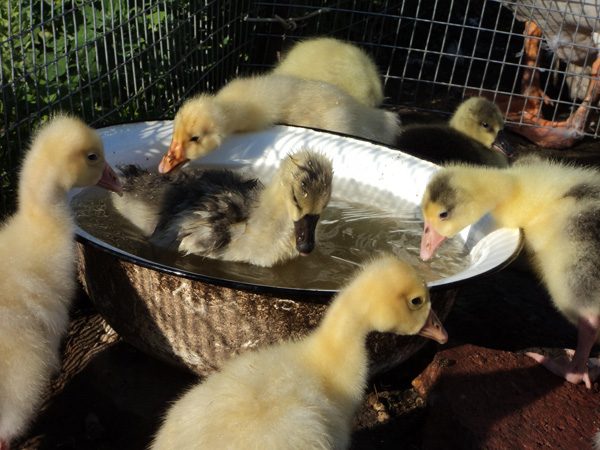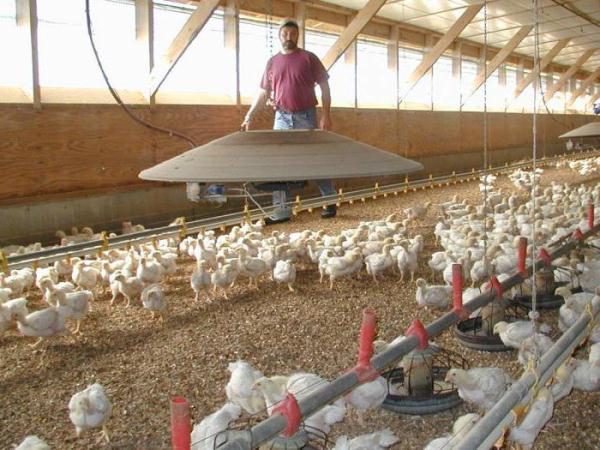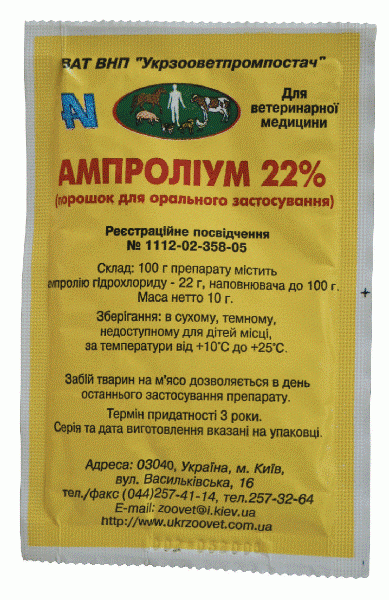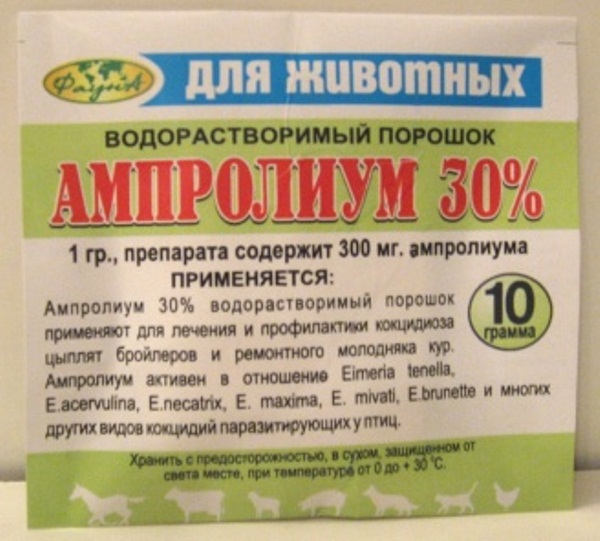Growing poultry is very popular for many farmers and homeowners. To obtain a qualitative result of its activities, certain preventive measures should be taken. Coccidiosis is considered a common disease in poultry., the fight with which we describe in this article using the drug amprolium. Pharmacological properties and instructions for use of the drug can be found below.
Table of contents
For which diseases is amprolium used
Amprolium hydrochloride, which is the active ingredient of this drug, contributes to the inhibition of growth of coccidiosis parasites. The drug is effective in schizogony of the first two generations.. Also, it should be noted that amprolium does not have any detrimental and depressing effects of immunity.
Major diseases, which are directed to the action of the drug, is:
- Coccidiosis;
- Eymerioz;
- Cestosis;
- Trematodosis;
- Entomoz.

The success and effectiveness of the fight against coccidiosis parasites is based on the quality of feeding and keeping of poultry. So, on the effectiveness of any coccidiostatics can have a certain impact following factors:
- Mode temperatures;
- Quality used bedding;
- Humidity premises;
- Conditions feeding;
- Appearance intercurrent diseases;
- Types coccidia;
- The sensitivity of parasites to the drug, etc.
Consequently, the problem of the occurrence and spread of coccidiosis can be solved only with the integrated use of the correct content of poultry using amprolium, adhering to the instructions and recommended dosages.
How to apply for chicks, instruction
Amprolium is applied by adding a powdered substance to the feed mixture or drinking water.
For chickens
With drinking water
- In order to prevent - used for poultry aged from three days to 16-17 weeks, observing a daily dose of 400-420 g of powder per 500-550 liters of water or 250 mg of hydrochloride per liter of pure water.
- Treatment - therapy is carried out for one week, adhering to the daily allowance - 400-420 g of powder for 500-550 liters of water or 250 mg of hydrochloride per liter of pure water.
With feed
- In order to prevent - the drug is also used only for birds aged from three days to 17 weeks, in a daily dose of 400 g of the drug per ton of feed, or 125 mg of amprolium hydrochloride per kilogram of feed.

- Treatment - 850 g of amprolium per ton of feed or 125 mg of amprolium hydrochloride per kilogram of feed mixture for 8-12 days.
For broiler chickens
With drinking water
- In order to prevent - to birds aged from three days to 16 weeks, observing the daily rate of 200 g of powder per 500-550 liters of water or 120 mg of hydrochloride per liter of pure water. Five days before slaughter, you should finish taking the drug.
- Treatment - produced within seven days, maintaining the recommended daily dosage - 350-380 g of powder for 500-550 liters of water or 230 mg of hydrochloride per liter of pure water.

With feed
- In order to prevent - it is used for animals aged from three days to 16 weeks, adhering to a daily dosage of 350-400 g of the drug per ton of feed or 120 mg of amprolium hydrochloride per kilogram of feed.
- Treatment - during 6-10 days, a preparation should be given to birds based on the proportion of 800 g of amprolium per ton of feed or 120 mg of preparation per kilogram of feed mixture.
For goslings, turkey poults and other birds
With drinking water
- In order to prevent - Amprolium should be used for poultry having an age from 3 days to 15-16 weeks. It is necessary to adhere to the daily dose of the drug - 300-350 g of powder for 500-600 liters of water or 220 mg of hydrochloride per liter of pure water.
- Treatment - therapy is carried out for one week, adhering to the daily rate - 400 g of powder per 500 liters of water or 230 mg of hydrochloride per liter of pure water.

With feed
- In order to prevent - the product is effective for poultry of the above-described age, while observing daily doses per 300 g of the preparation per ton of feed or 130 mg of amprolium hydrochloride per kilogram of feed.
- Treatment - 800 g of amprolium per ton of feed or 120 mg of amprolium hydrochloride per kilogram of feed mixture for 8-12 days.
For adult birds
Adult birds the drug should be used in a concentration of 0.1% of the feed mixture. This is necessary to avoid negative and adverse effects on the body of an adult bird.
Side effects
In the process of using the drug in the stated doses no side effects have been identified.
Also, it is noted that in case of small overdoses, amprolium is a safe drug. During the study, chickens tolerated a single dose of about 4 grams per kg of weight. Of the negative consequences there was only a small decrease in bird growth.
With continuous concentrated use of amprolium, 0.05% chickens calmly endured stress without significant consequences for growth.
Contraindications
Amprolium is considered undesirable for use by its repair young growth over 15 weeks of age and for laying hens. This is due to the penetration and subsidence of the active substances in chicken eggs, which is harmful to the human body.

The drug is banned for simultaneous use with other medicines.having an anti-coccid effect. It is possible to kill birds not earlier than a week after the end of the medication. The need for earlier slaughter obliges the use of poultry as feed for other animals.
Actions with the drug should be carried out only in overalls and personal protective equipment.. Also in the process of preparing a drug is prohibited to smoke, eat food and water. At the end of the work, it is necessary to wash the exposed parts of the body well under running water.
Pharmacological properties
Amprolium has the following properties:
- It has a wide anticoccidian effect on anticoccidian parasites.
- The active functioning of amprolium hydrochloride is in the immediate vicinity of the chemical composition of the preparation with thiamine, which is necessary for the life of coccidia. Amprolium has better penetration into parasitic cells. for settling in the active centers of vitamin compounds. This allows you to damage carbohydrate metabolism and destroy the parasite.
- Non-toxic to birdsbecause the cell membrane of the intestinal membrane is impermeable to active substances of amprolium.

- Amprolium hydrochloride leaves the bird's body with droppings almost completely.
- A drug contributes to the formation of strong immunity for further struggle with coccidia.
- Amprolium is considered a low hazard substance., because it is not able to have a strong toxic effect on the organism of animals.
The drug is most used to fight coccidiosis of birds and animalsbecause it has several advantages:
- Promotes fast getting rid of signs of coccidiosis;
- The absence of side effects;
- Low toxicity substance;
- Does not provoke addictive;
- No negative effect. on the process of developing immunity of broilers.
